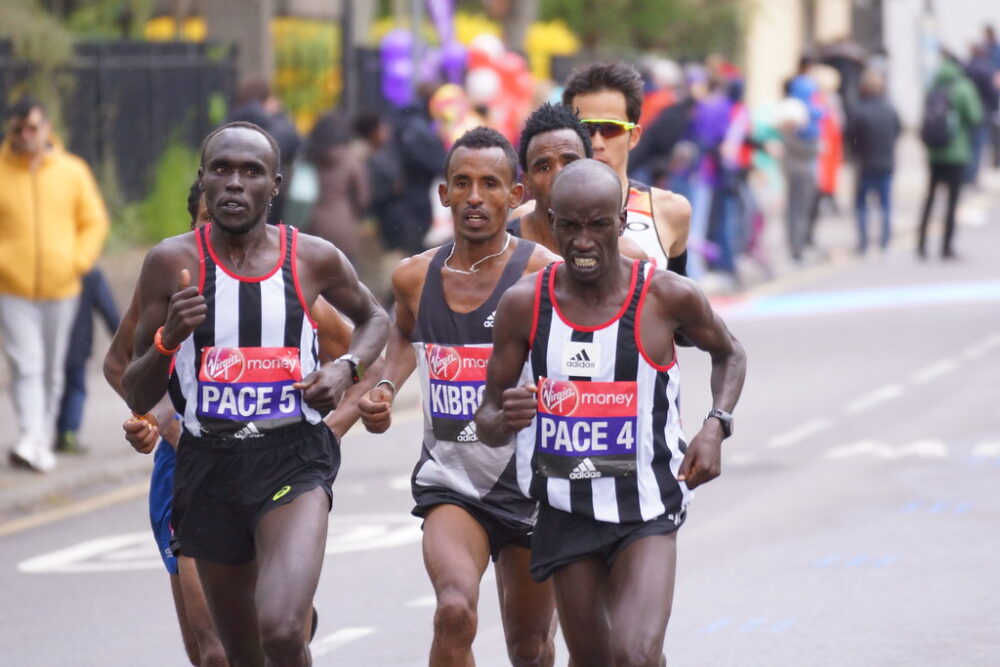Four minutes and thirty four seconds. That was Eliud Kipchoge’s mile time…for 26.2 miles. On October 12, 2019, the acclaimed Kenyan distance runner broke a barrier that was once thought to spell certain death: a sub-two hour marathon. While rules on pacing and fluid allowance and concerns surrounding equipment engineering prevented his run from being counted as a world record, Kipchoge’s time of 1:59:40 and unquestionable toughness will leave a permanent impact on the running world.
How did he do it? To start off, this feat was not the work of one sole runner. Kipchoge was accompanied by a rotating group of pacers, which included world-renowned athletes who all had a heightened awareness for pace, effort, and form. The squad ran in an inverted V formation, with Kipchoge sheltered from physical drag, the psychological burden of leading a race alone, and physiological resource depletion. This formation corresponds with findings dating back to Griffith Pugh’s 1971 physiology study in which a 65-kilogram athlete’s maximum rate of oxygen consumption increased from 3.01 to 5.01 liters per minute when subjected to 18.5 meters-per-second winds while running a standard marathon pace of 6 minutes per mile. Kipchoge was also assisted by bike-delivered fluids like water and electrolytes as opposed to the traditional run-by tables stocked with supplies, cutting seconds off his run by eliminating the need to deviate from the shortest span of the course.
how will we determine the competition legality of technological, nutritional, and medical advancements regarding sport as we continue to innovate?
As far as environmental conditions go, Kipchoge’s experience was also optimized. The INEOS 1:59 Challenge in Vienna, Austria was held just for him with the venue and course reserved for a number of days to maximize the chance for ideal weather. On the day of the legendary run, the temperature hovered between 5 to 9 degrees Celsius with humidity below 80 percent and minimal wind — right within the preferred range for faster runners like Kipchoge, who generate larger amounts of heat while performing. Vienna is located a mere 156 meters above sea level, a staggering improvement to oxygen availability compared to Kipchoge’s 2400-meter-high training camp in Kenya. The course itself was structured to minimize climb and turns, as right angles have been found to add an average of one second apiece to a runner’s marathon time, and was also lined with trees to further reduce drafts that could work against the runners’ momentum.
The grit of the individual athlete is but one factor in a whirlwind of advancements that remains unadulterated and defining.
The most controversial aspect of this race, and the one that leaves the sports world with the most questions, were Kipchoge’s shoes. Kipchoge wore a prototype of Nike’s AlphaFly. The stiff carbon plate embedded in the shoe’s midsole has been employed in marathons before this one, and raises concerns about so-called “mechanical doping.” A 2017 study was conducted regarding the performances of 18 athletes during a 5-minute trial run with and without the assistance of a carbon midsole. The addition of the carbon plate technology lent an average 4 percent decrease in energy exertion, measured through oxygen uptake and respiratory exchange ratios. When equalized for weight, a prototype of the Nike VaporFly shoe gave all the runners an energy advantage because of its ability to return the force exerted back to the athlete through recoil of the midsole. This raises questions that will come to influence the future of running and will exist in the world of sports for years to come. Will technologies like these become patented and owned by select companies, creating an unfair advantage for certain athletes and causing equipment bans like that of the Speedo tech suits in swimming? Or will they positively contribute to the revolutionization of sport by becoming commonplace across manufacturers? And how will we determine the competition legality of technological, nutritional, and medical advancements regarding sport as we continue to innovate? The answers to these queries remain foggy, but one thing is certain: Kipchoge himself deserves much more credit than this article has given him. The grit of the individual athlete is but one factor in a whirlwind of advancements that remains unadulterated and defining.
Image source: Flickr






